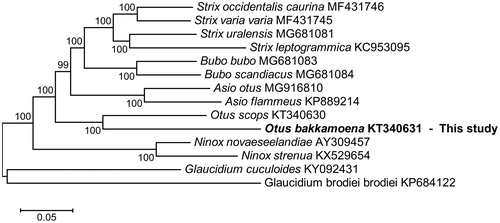Abstract
The Indian scops owl Otus bakkamoena (Aves, Strigiformes, Strigidae) is a small resident owl in southern Asia. The complete mitochondrial genome sequence consisted of 17,389 base pairs (bp) encoding 13 protein-coding genes (PCGs), 2 ribosomal RNAs (rRNAs), 22 transfer RNAs (tRNAs) and non-coding regions. The overall base composition of O. bakkamoena was G + C: 44.6%, A + T: 55.4%, apparently with a slight AT bias. Phylogenetic analysis showed that O. bakkamoena was closely related to Otus scops.
Keywords:
The Eurasian scops owl Otus bakkamoena (Aves, Strigiformes, Strigidae) is a small resident owl in southern Asia. Through O. bakkamoena’s natural camouflage, it is difficult to find. Therefore, there is difficulty in studying the mitogenome of the O. bakkamoena. The carcass of O. bakkamoena was collected at Yeongju-si Branch of Korea Society for the Protection of Wild Animals in Yeongu-si city (36.852521 N 128.576801 E), Republic of Korea. This specimen was deposited in the Institute of Ornithology, Kyungpook National University, Daegu, Republic of Korea.
In the present study, the mitogenome of O. bakkamoena was completely sequenced and submitted to GenBank: (accession number: KT340631). The sequence was compared with our previously research mitogenome sequence of O. scops. The mitochondrial DNA was amplified into two overlapping segments by a long-range PCR method (Koh et al. Citation2018). DNA shotgun sequencing was operated by an Ion PGM™ system (Life Technologies, Gaithersburg, MD), and genome assembly was carried out using the CLC Genomics Workbench 7.5 program (CLC Bio, Denmark) (Park et al. Citation2018).
The mitogenome was 17,389 bp in size, consisting of 13 protein-coding genes (PCGs), 2 ribosomal RNAs (rRNAs) genes, 22 transfer RNAs (tRNAs) and non-coding region. All the PCGs (ND1, ND2, CO2, ATP8, ATP6, CO3, ND4L, ND4, CytB, ND6) shared start codon ‘ATG’, except for CO1, ND5 (start codon ‘GTG’) and ND3 (start codon ‘ATT’). Regarding the stop codons, 6 PCGs (CO2, ATP8, ATP6, ND3, ND4L, ND5) shared stop codon ‘TAA’, 4 PCGs (ND2, CO3, ND4, CytB) shared the incomplete stop codon ‘T’, 2 PCGs (ND1, CO1) terminated with AGG, and ND6 terminated with TAG. The two rRNA genes were 12S rRNA (980 bases) and 16S rRNA (1587 bases). The D-loop (1845 bases) was located between tRNA-Glu and tRNA-Phe. The overall base composition of O. bakkamoena was G: 13.6%, C: 31.0%, A: 30.9%, T: 24.5%, apparently with a slight AT bias (G + C: 44.6%, A + T: 55.4%).
We compared the results from the present study to previous mitogenome research on the family Strigidae (Harrison et al. Citation2004; Liu et al. Citation2014; Sarker et al. Citation2016; Sun et al. Citation2016; Zhang et al. Citation2016; Hanna et al. Citation2017; Kang et al. Citation2018; Lee et al. Citation2018). Phylogenetic analysis based on the mitogenome sequences using the maximum likelihood general time reversible model (GTR) with gamma distributed (G) plus Invariant sites (I) method showed that, the O. bakkamoena was closely related to O. scops (). Thus, the O. bakkamoena mitogenome sequence can contribute to phylogenetic knowledge of the genus Otus and expand the basis of the owl species.
Disclosure statement
No potential conflict of interest was reported by the authors.
References
- Hanna ZR, Henderson JB, Sellas AB, Fuchs J, Bowie RC, Dumbacher JP. 2017. Complete mitochondrial genome sequences of the northern spotted owl (Strix occidentalis caurina) and the barred owl (Strix varia; Aves: Strigiformes: Strigidae) confirm the presence of a duplicated control region. PeerJ. 5:e3901.
- Harrison GL, McLenachan PA, Phillips MJ, Slack KE, Cooper A, Penny D. 2004. Four new avian mitochondrial genomes help get to basic evolutionary questions in the late Cretaceous. Mol Biol Evol. 21:974–983.
- Kang H, Li B, Ma X, Xu Y. 2018. Evolutionary progression of mitochondrial gene rearrangements and phylogenetic relationships in Strigidae (Strigiformes). Gene. 674:8–14.
- Koh H, Park GS, Shin SM, Park CE, Kim S, Han SJ, Pham HQ, Shin J-H, Lee DW. 2018. Mitochondrial mutations in cholestatic liver disease with biliary atresia. Sci Rep. 8:905.
- Lee MY, Lee SM, Jeon HS, Lee SH, Park JY, An J. 2018. Complete mitochondrial genome of the Northern Long-eared Owl (Asio otus Linnaeus, 1758) determined using next-generation sequencing. Mitochondrial DNA Part B. 3:494–495.
- Liu G, Zhou L, Gu C. 2014. The complete mitochondrial genome of Brown wood owl Strix leptogrammica (Strigiformes: Strigidae). Mitochondrial DNA. 25:370–371.
- Park YJ, Park CE, Lee SH, Ko HS, Ullah I, Hwang UW, Shin JH. 2018. The complete mitochondrial genome sequence of the intertidal crab Parasesarma Tripectinis (Arthropoda, Decapoda, Sesarmidae). Mitochondrial DNA Part B. 3:193–194.
- Sarker S, Das S, Forwood J, Helbig K, Raidal SR. 2016. The complete mitochondrial genome sequence of an Endangered powerful owl (Ninox strenua). Mitochondrial DNA Part B. 1:722–723.
- Sun X, Zhou W, Sun Z, Qian L, Zhang Y, Pan T, Zhang B. 2016. The complete mitochondrial genome of Glaucidium brodiei (Strigiformes: Strigidae). Mitochondrial DNA Part A. 27:2508–2509.
- Zhang Y, Song T, Pan T, Sun X, Sun Z, Qian L, Zhang B. 2016. Complete sequence and gene organization of the mitochondrial genome of Asio flammeus (Strigiformes, strigidae). Mitochondrial DNA Part A. 27:2665–2667.

